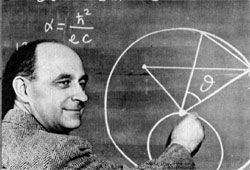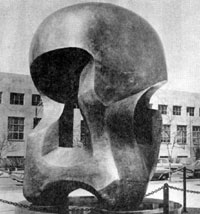NAL Dedication Set for May 11
The National Accelerator Laboratory will become the Fermi National Accelerator Laboratory at a dedication ceremony to be held at the Laboratory on Saturday, May 11, 1974.
The plan to change the name of the Laboratory was announced on April 29, 1969 by Glenn T. Seaborg, then chairman of the U.S. Atomic Energy Commission, It was understood then that the dedication and the changing of the name would take place when construction was complete. May of 1974 will find the Laboratory close to completion and running strongly in all areas.
In announcing the AEC's plans, Seaborg said in 1969: "It is particularly fitting that we honor Dr. Fermi in this manner, for in so doing we further acknowledge his many contributions to the progress of nuclear science, particularly his work on nuclear processes. Enrico Fermi was a physicist of great renown who contributed in a most significant way to the defense and welfare of his adopted land and to the enhancement of its intellectual well-being. His greatest achievement, the first sustained nuclear chain reaction, took place in a small laboratory in Chicago. It seems singularly appropriate, therefore, that the Federal Government recognize the memory of a man who was at the forefront of science in his day by naming in his honor a laboratory near Chicago - a laboratory which will have a major international impact on our understanding of the basic structure of matter."
Enrico Fermi was born in Rome, Italy, on September 29, 1901. He died November 28, 1954. The son of a railroad official, he studied at the University of Pisa from 1918 to 1922 and later at the Universities of Leyden and Gottingen. He became professor of theoretical physics at the University of Rome in 1927. He was a leading figure in a group whose influence has been felt in science and physics throughout the world, which included Emilio Segre, Edoardo Amaldi, Oscar D'Agostino and Bruno Rossi.
Fermi's accomplishments were in both theoretical and experimental physics, a unique feat in an age in which scientific endeavors have tended to specialize on one aspect or the other. In 1926 he proposed a theory of statistical mechanics to explain the behavior of electron gas degeneracy. In 1933 he developed the theory of beta decay, postulating that the newly discovered neutron decaying to a proton emits an electron and a particle which he called a "neutrino." The theory of a new force to explain this interaction later resulted in recognition of the weak interaction force, now known to be one of the family of four major forces. Over the last year, remarkable new discoveries have been made at NAL and CERN which have shed new light on the field of weak interactions which Fermi opened.
Experimentally, Fermi and his colleagues studied the behavior of the new particles; they bombarded all elements in the periodic table with the neutrons. They slowed down the neutrons, and produced a strange new product when bombarding uranium with neutrons which later was seen to be a splitting of the uranium atoms.
Fermi used the opportunity offered by the trip to Sweden to receive the Nobel Prize in 1938 to leave Italy, with his wife, son, and daughter, all growing restive under the Fascist regime. They came to the United States where Fermi accepted a position as Professor of Physics at Columbia University. It was by now recognized that nuclear fission (the splitting of the atom) had taken place in Fermi's and other similar experiments. Scientists recognized that this principle could be applied to construct an "atomic bomb," of tremendous import to world affairs in the early 1940's. The United States government formed the Manhattan Project to produce the first such bomb. Fermi moved to the University of Chicago and was placed in charge of building the first atomic pile in the squash court under the West Stands of the University's Stagg Field. Today, a plaque at the site reads: "On December 2, 1942, man achieved here the first self-sustaining chain reaction and thereby initiated the controlled release of nuclear energy."
At the end of World War II, the University of Chicago formed its Institute for Nuclear Studies, to keep together the scientists who had worked in the Metallurgical Laboratory on the development of the atomic bomb. Fermi joined the staff and continued his investigations of the nucleus of the atom, concentrating on the nature of the particles that make up the nucleus. He was very active in the design of the synchrocyclotron at the University which was, at the time of its completion, one of the most powerful atom smashers in the world. The magnet from this machine has been moved to the Muon Area of the National Accelerator Laboratory and in 1973 began to operate as a spectrometer for Experiment #98 here.
Fermi's theoretical work continued. He worked on the origin of cosmic rays and in developing a statistical method for treating high-energy collision phenomena and multiple production of particles.
Emilio Segre, a colleague of Fermi for many years, writing in the Dictionary of Scientific Biography in 1971, recalls, "During the postwar Chicago years, Fermi traveled a good deal, particularly to research centers, where he could meet young, active physicists. He repeatedly visited the Brookhaven National Laboratory, the Radiation Laboratory in Berkeley, the Los Alamos Laboratory, and many universities. He was welcomed everywhere, especially by the younger men who profit from these contacts with him and, in turn, helped Fermi to preserve his youthful spirit."
Present plans for the dedication observance on May 11 include a luncheon for distinguished guests at noon in the Central Laboratory cafeteria. Among the guests will be congressmen and State of Illinois officials. Mrs. Fermi will also participate in the dedication ceremony. A tour for the guests will be given from 2:00 to 3:00 p.m. The dedication ceremony will begin at 3:30 p.m. Tours for others attending the occasion will be given after the ceremony.
Further details and arrangements for employees, their families and guests, and for the general public will be announced about May 1.
Donald R. Getz, Assistant Director of NAL, is in charge of the dedication arrangements.
At the end of World War II, the University of Chicago formed its Institute for Nuclear Studies, to keep together the scientists who had worked in the Metallurgical Laboratory on the development of the atomic bomb. Fermi joined the staff and continued his investigations of the nucleus of the atom, concentrating on the nature of the particles that make up the nucleus. He was very active in the design of the synchrocyclotron at the University which was, at the time of its completion, one of the most powerful atom smashers in the world. The magnet from this machine has been moved to the Muon Area of the National Accelerator Laboratory and in 1973 began to operate as a spectrometer for Experiment #98 here.
Fermi's theoretical work continued. He worked on the origin of cosmic rays and in developing a statistical method for treating high-energy collision phenomena and multiple production of particles.
Emilio Segre, a colleague of Fermi for many years, writing in the Dictionary of Scientific Biography in 1971, recalls, "During the postwar Chicago years, Fermi traveled a good deal, particularly to research centers, where he could meet young, active physicists. He repeatedly visited the Brookhaven National Laboratory, the Radiation Laboratory in Berkeley, the Los Alamos Laboratory, and many universities. He was welcomed everywhere, especially by the younger men who profit from these contacts with him and, in turn, helped Fermi to preserve his youthful spirit."
Present plans for the dedication observance on May 11 include a luncheon for distinguished guests at noon in the Central Laboratory cafeteria. Among the guests will be congressmen and State of Illinois officials. Mrs. Fermi will also participate in the dedication ceremony. A tour for the guests will be given from 2:00 to 3:00 p.m. The dedication ceremony will begin at 3:30 p.m. Tours for others attending the occasion will be given after the ceremony.
Further details and arrangements for employees, their families and guests, and for the general public will be announced about May 1.
Donald R. Getz, Assistant Director of NAL, is in charge of the dedication arrangements.





